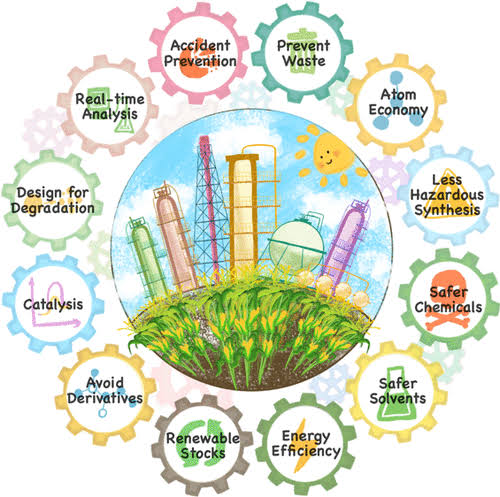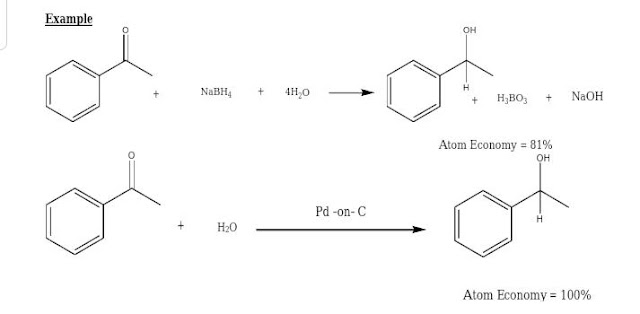How Principles of Green Chemistry can help in Sustainability of Environment?
What is Green Chemistry?
How principles of green chemistry can help in the sustainability of the environment?
The topic or article will cover the following questions and their answers.
· Examples of green chemistry
· Why is green chemistry important?
· What is sustainable chemistry?
· Green chemistry principles
· Basics of Green Chemistry
· Green chemistry pdf
· Green chemistry projects
· Benefits of green chemistry
· Green chemistry applications
· Importance of green chemistry
· Green chemistry impact
· Green chemistry examples
· 12 principles of Green Chemistry
· Green chemistry definition
· The trend of Green chemistry in sustainability of environment
· what is green chemistry currently working on
· How Green Chemistry does accommodates the principles sustainability of the environment
· Applications of green chemistry in sustainable development.
· How green chemistry differs from cleaning up pollution
· Green Chemistry Domains
What
is Green Chemistry?
In the early 1990s
the term green chemistry was introduced by the Environmental Protection Agency
and agency of the US government. Actually, green chemistry is vast terminology
it cannot be limited up to just definition, in this era of Revolution new
Technologies are used to generate hazardous substances in the design
manufacturer and application of chemical products so green chemistry is the
utilization of a set of principle that reduces or eliminates the use of this type
of hazardous substances. Green chemistry is also known as sustainable
chemistry.
Goals of Green chemistry:
All the
researchers and Frontiers of green chemistry are trying to reduce the
environmental impact of the chemical Enterprises by developing technology the base that is inherently non-toxic to living things and the environment, So
Green chemistry is a scientific approach towards the control of environmental factors.
These factors are known as the greenhouse effect, global warming, acidic rain, etc. Those
cause climate change.
Green chemistry Domains
·
Covered all the discipline of chemistry
not limited to the single one discipline.
·
Reducing the intrinsic hazards of the
processes that design chemical products.
·
Trying to mask the hazards from existing
products and processes.
·
Eliminating the harmful impact of
chemical products and processes on the environment and human health.
·
Also trying to control the pollution at
the molecule level in the environment.
How green chemistry differs from cleaning up
pollution?
In nowadays the major purpose of green chemistry is to control the pollution by minimizing the
hazards of chemical food stocks, chemicals Regent, and products. It is
different from remediation which is actually the treatment of West materials by
·
Reducing
·
Recycling
·
And reusing
Let mediation
involve the removal of hazardous material from the environment while on the other
hand the priority of the green chemistry is to keep the hazardous material out
of the environment in the first place.
Green chemistry principles
There are 12
principles of Green Chemistry that are helpful in the sustainability of the
environment all of these are discussed below in detail, that how these
principles are helpful in sustainability.

1. Prevention of West materials in green chemistry
It is better to prevent the production of waste
rather than a letter on cleaning up the waste materials. it is great to step towards the production of minimum or no waste materials in the environment. By doing
this we can prevent many hazards regarding the waste materials such as
storage, transportation, and treatment of the waste material.
For
example the synthesis of phenol:
Phenol is production is a multi-stage process. It
takes place by the reaction between benzene, sulfuric acid, and sodium
hydroxide.
2. Atom economy principal in green chemistry
Design such reactions route that the final product
contains a maximum yield of all the starting material. Minimum or no atoms of
starting material are produced. For this process search chemical
transformations are generated which maximize is the integration of all the
materials used in the process, show a greater deficiency, and contribute to the
deduction of waste material.
the value of an atom economy of the manufacturing of phenol is only 37%. As the value of the atom economy nearest to the hundred then the lesser amount of waste products are produced.
3. Produce less toxic
chemical synthesis in green chemistry
Develop such chemicals that show
their maximum functionality on the other hand show less toxicity. These solvents
are known as a green solvent. This green solvent shows a number of characteristics
·
No mutagenicity
·
Nonvolatile
·
Low toxicity
·
And widespread availability as compared
to others
These greens solvent are cheaper and can be handled easily one of
the most interesting thing is that this solvent can be recycled.
For example, diphenyl carbonate shows
less hazardous effect than the carbonyl chloride. Dimethyl carbonate when
heated with phenol in the liquid face then diphenyl carbonate is formed.
4. Synthesis of safer
solvents and auxiliaries in green chemistry
The
auxiliary substances can be used as a solvent, to separate the substances, to extract
the desired material. So these substances should be less toxic, show no sort of hazardous effect, non-bio accumulated, and no mutation causing agent.
Ford example supercritical carbon dioxide is the most common Benign solvent.
5. Design for energy
efficiency in green chemistry
All the synthetic processes utilize energy to convert raw material into the final product. This energy is used in the form of fossil fuels in this way our fossil fuels are consuming day by day. To avoid the production of waste it is compulsory, those chemical processes or products should be designed that are helpful in obtaining the desired product and maximum yield at the cost of low energy. This chemical processes proceed at ambient temperature so that a suitable catalyst can be used
For example, the higher the process is used for the formation of ammonia. This election proceeds at a temperature of 673K-723K and the catalyst used for this reaction is iron.
6. Use of renewable
feedstocks in green chemistry
Many chemical industries used oils for their product synthesis. For the development of sustainability, we should reduce the exploitation of non-renewable natural resources for example petroleum, coal, and natural gas, etc. The renewable resources are restored by the natural processes and biochemical cycles show their sustainable development is not a big problem.
Example, Wheat, and rice are used in the formation
of furfural in the form of bagasse and biomass.
7. Reduce the synthesis of chemical derivatives in green chemistry
The protective groups for the
blocking groups is used in the chemical processes to reduce the waste
material, so avoid such type of blocking or protecting materials.
For example, enzymes are used to
avoid protecting groups of semi-synthetic antibiotics such as ampicillin and
amoxicillin in industries.
8. Catalyst in green
chemistry
The chemical substance that is used to accelerate
the rate of a chemical reaction by lowering its activation energy this also has the ability
to regenerate itself at the end of the reaction is known as a catalyst.
·
It is used in small quantities.
·
The use of catalyst reduces the energy
demand by lowering the temperature and pressure of the chemical reaction.
·
The enable the other side reactions and
by this way, better atom economy can be obtained and waste material production
is minimized.
in the first reaction no catalyst
is used so obtained atom economy is only 81%. While in the second reaction pd on
carbon is used as a catalyst so it increases the atom economy i.e 100%.
9. Design benign chemicals in green chemistry
Search chemical processes are
design that produces the products that are highly selective in nature and affect
their desired functions and minimizing the toxicity and biotransformation.
For example 2, 4-D is a selective pesticide
which kills only broadleaf weeds.
10. Design for
degradation in green chemistry
The chemical reactions are designed
in such a way that their products, as well as waste materials, can be decompose
in the natural environment. Physical-chemical and biochemical processes are used to
break down the desired products into harmless small substances, so that these
products cannot be accumulated in nature and show bio magnifications.
For example; thermoplastic
aliphatic polyester poly acetic acid is a biodegradable and bioactive chemical
substance.
11. Real-time analysis for pollution prevention in
green
chemistry
The chemical processes should be observed at different variables to control the formation of
desired products. I. This way the
production of toxic substances as by-product can be controlled.
12.
Inherently Benign chemistry for accident prevention in green chemistry
The physical state of the product
in the chemical processes like gaseous, solid, and liquid are designed to reduce
the possibilities of chemical accidents like explain, fire, and production of smoke due to chemicals and there
release into the natural environment. The chemical accidents occur due to hazardous
substances. Those substances that are hazardous maybe
·
corrosive,
·
flammable,
·
explosive,
·
Reactive and toxic.
To prevent this chemical substance preventive measures regarding laboratory should be e adopted.
For example, the sodium salt of 2, 2-iminodiethanoic acid is used as
an intermediate for the manufacturing of herbicide glyphosphate. 2,
2-iminodiethanoic acid is produced by the reaction between ammonium ethanal and
hydrogen cyanide. Hydrogen cyanide is very toxic so to reduce its toxicity the
starting materials are ammonia and epoxyethane. It is a safer process to obtain
the final product without any harmful effects.
Trend of Green
chemistry in the sustainability of the environment
In the world of chemicals and its processes Green chemistry is a new train for designing the chemicals. it helps in achieving sustainability in chemical production by reducing its harmful effects on the human and environment. Following are some important priorities of Green chemistry
· Green chemistry For designing the chemical roots of the
reactions incorporate sustainability in the design.
· Green chemistry Source reduction of waste material.
· Green chemistry Synthesize such materials are chemicals that are eco-friendly.
· Green chemistry Analyze the environmental effects of biomass processing and eco-toxicology.
· Green chemistry Use those solvent systems that are safe for the environment.
· Green chemistry is trying to produce search industrial processes that it has problems for humans and as well as for the environment. Are trying to produce such industrial processes that ever have problems for humans and as well as for the environment.
· Green chemistry Generating wealth from the use of waste materials i.e. by prevention of waste material, minimization in hazardous products, base metal catalysis, solar cell.
For all these reasons it is said that Green chemistry and its principle helps in the sustainability of the environment.
Note:
This article title “What is green chemistry? How
principles of green chemistry can help in the sustainability of environment’ credit
goes to Sumayya khadim M.Phil. Chemistry Scholar, Government college women
university, Faisalabad, Punjab Pakistan.











No comments:
Post a Comment